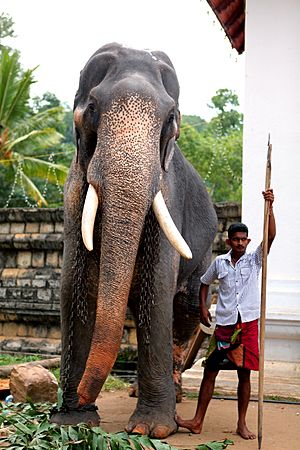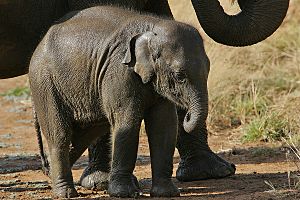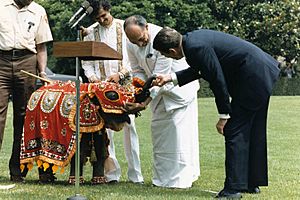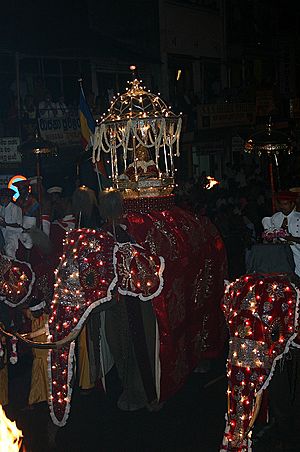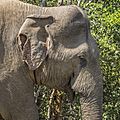Sri Lankan elephant facts for kids
Quick facts for kids Sri Lankan elephant |
|
|---|---|
 |
|
| Male Sri Lankan elephant | |
 |
|
| Female elephants at the Pinnawala Elephant Orphanage | |
| Conservation status | |
| Scientific classification |
|
| Kingdom: | Animalia |
| Phylum: | Chordata |
| Class: | Mammalia |
| Order: | Proboscidea |
| Family: | Elephantidae |
| Genus: | Elephas |
| Species: | |
| Subspecies: |
E. m. maximus
|
| Trinomial name | |
| Elephas maximus maximus Linnaeus, 1758
|
|
 |
|
| Range of the Sri Lankan elephant | |
The Sri Lankan elephant (Elephas maximus maximus) is a special type of Asian elephant. It is one of three different kinds, called subspecies. The other two are the Indian elephant and the Sumatran elephant.
Sri Lankan elephants are the biggest of the three Asian elephant types. They can be about 11 feet (3.4 m) tall. They can also weigh up to 12,000 pounds (5,400 kg). These huge animals eat leaves, shrubs, grasses, and other plants.
This elephant is the national animal of Sri Lanka. It lives only on this island country. Long ago, they lived all over the island. Today, they mostly live in dry areas. These areas are in the north, east, and southeast. They include dry deciduous woodland, scrubland, grassland, and marshes. A small group also lives in the rainforest.
Some Sri Lankan elephants work with people. They help carry timber. They also give rides to people. They take part in important public events. One such event is the Procession of Buddha's Tooth. In the past, many elephants were hunted.
Today, you can see these elephants in Sri Lanka's national parks. You can also find them in elephant orphanages. They are an endangered species. This means they are protected by law. Harming one can lead to very serious penalties.
Contents
About Sri Lankan Elephants
Asian elephants are usually smaller than African elephants. Female elephants are often smaller than males. Elephants can live for about 60-70 years in the wild. In places where they are cared for, they can live over 80 years. Older elephants might have trouble eating. This happens when their teeth wear out or fall out.
The highest part of an Asian elephant's body is on its head. The tip of their trunk works like a finger. Their back can be curved upward or flat.
Their ears are smaller than those of African elephants. Their feet have more nails. They have five nails on each front foot. They have four nails on each back foot. Only a few male Sri Lankan elephants grow tusks. Female elephants do not have tusks. Their skin is darker than the other Asian elephant types. They may have big patches of lighter skin. These patches can be on their ears, face, trunk, and tummy.
Sri Lankan elephants are the largest Asian elephant subspecies. They stand between 6 and 11 feet tall at the shoulder. They weigh between 4,000 and 12,000 pounds.
Elephants have a very large and developed brain. They are very smart animals. In fact, elephants have the biggest brain of all land animals. They also have amazing memories. They can remember places, people, and events from a long time ago.
Where Sri Lankan Elephants Live
The Sri Lankan elephant once lived all over Sri Lanka. But over the last 200 years, people have used more land. This has pushed the elephants out of wet, fertile areas. Now, they mostly live in the drier parts of the north, east, and southeast. These dry areas are mostly woodlands, scrub, grasslands, and marshes.
Elephant Family Life
Like other Asian elephants, Sri Lankan elephants live in groups. These groups are made up of family members. An older, experienced female leads the group. She is called the matriarch.
Sometimes, a group might join another group. This forms a larger group called a clan. Clans can then join to form an even bigger group, called a herd. These groups are centered around females. They include grandmothers, mothers, daughters, sisters, and aunts.
Young male elephants stay with the group. But when they grow up, the females make them leave. This helps prevent them from mating with their close relatives. These young males might then join other groups of males. Or they might live on their own.
Growing Up as an Elephant
A grown male elephant is called a bull. A grown female elephant is called a cow. Their babies are called calves. Calves drink milk from their mothers for 2 to 5 years. They form strong bonds with their mothers. All the female elephants in the group help raise and protect the calves.
Male calves often leave their mothers to play. Their play involves pushing heads, pretending to fight, and chasing. Female calves like to play chasing and running games. They also throw sticks and might pretend to fight. Both male and female calves enjoy rough and tumble games together.
Male Elephants and Their Journeys
When male elephants become teenagers, they reach sexual maturity. At this time, the matriarch and other females will chase them away. This prevents them from having babies with their relatives. Babies from such close family unions might not be as strong.
Young males often form groups with other males. Very few male Sri Lankan elephants grow tusks. Female elephants do not have tusks at all. As males get older, they often prefer to be alone. Adult males only join females for mating. They do not help raise the young elephants.
What Elephants Eat
Sri Lankan elephants eat leaves, grasses, shrubs, and vines. Sometimes, they go into farm gardens. There, they eat crops like sugar cane or bananas. Baby and young elephants mostly eat different types of grasses.
Sri Lankan elephants both browse and graze. This means they eat while walking. They also stand still and eat what they can reach.
Adult elephants eat a lot of food. They need 300-400 pounds of food every day. This helps them keep their huge bodies healthy. These elephants spend up to 16 hours a day eating. They also drink a lot of water. They drink from 25 to 50 gallons daily.
Reproduction and Life Cycle
Male Asian elephants become ready to have babies in their early teens. During this time, they enter a yearly phase called "musth." This is when they become more aggressive. They will fight other males to mate with a female.
After a male and female mate, a baby elephant grows inside the mother. This baby is called a calf. The calf is born after 18 to 22 months. When born, a calf weighs about 220 pounds. Having twins is very rare for elephants.
Babies stop drinking milk from their mothers between 18 months and 3 years old, or even longer. Female calves stay close to their mothers. This helps them build strong bonds. Male calves often go away from their mothers to explore and play.
After a mother gives birth, she usually waits to have another baby. She waits until her first calf stops drinking milk. This means there is usually a 4 to 5 year gap between births. Mothers stay with their herd. But grown males are driven away.
Elephants and People
Long ago, there were hundreds of thousands of Sri Lankan elephants. They lived all over the island. People from Sri Lanka, other parts of Asia, and Europe hunted them a lot.
In the 1800s, one British officer reportedly killed 1,500 elephants. Other British officers also hunted many. Between 1829 and 1855, more than 6,000 elephants were caught and killed.
In 2014, there were about 4,000 elephants living in Sri Lanka. The Sri Lankan elephant is now protected by law. This law is called the Fauna and Flora Protection Ordinance of Sri Lanka (FFPO). Killing an elephant can lead to very serious penalties.
Sri Lankan elephants are important to Sri Lanka's economy and culture. Some elephants work. They help carry timber. But now, machines like tractors are taking their jobs.
You can see elephants in protected areas and national parks. These elephants attract tourists. This helps the economy and the people of Sri Lanka.
Elephants have always been highly respected in Sri Lankan culture. Rajah, a Sri Lankan elephant with tusks that almost touched the ground, was declared a national treasure in 1985.
Sri Lankan elephants take part in special events. These include ceremonies and parades. The Esala Perahera is a famous festival in Kandy, Sri Lanka. It is thought to be from the 3rd century BC. Elephants lead this parade. They carry a sacred tooth.
Why Sri Lankan Elephants Are Endangered
Sri Lankan elephants face dangers, just like other Asian elephants. People are clearing forests to build farms and homes. This destroys the places where elephants live.
This has led to conflicts between elephants and humans. These conflicts can harm both elephants and people. They can also destroy property. The problem is made worse because elephants like to eat crops. They enjoy sugar cane, bananas, and other fruits grown by people.
In 1997, about 126 wild elephants died because of these conflicts. Also, fighting between government troops and a group called the Tamil Tigers has put elephants at risk.
Images for kids
See also
 In Spanish: Elefante de Sri Lanka para niños
In Spanish: Elefante de Sri Lanka para niños





